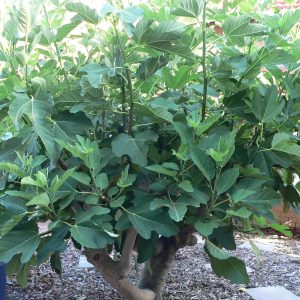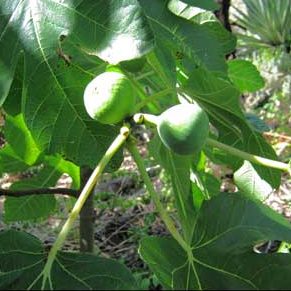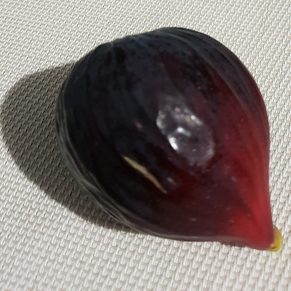Ficus carica
Fig
Origin
Figs go back in history several thousand years & became deeply entrenched in societal beliefs and religious rituals, with aspects of these practices still observed in many countries of the world today.
Climate
The fig grows well with a Mediterranean type climate such as Perth, with cool winters and a hot, dry summer. Water requirements are moderate, up to 1000 mm pa, and it has some drought tolerance. Young trees are susceptible to winter frost damage but mature trees are more resistant.
Plant Description
It is a semi-deciduous shrub or small tree, 7-10m tall, with soft wood and bark that is usually smooth and without fissures. The large dark green coriaceous alternate leaves, 15-30cm long, are 3-7 lobed with varying margins. All plant parts produce latex which can cause skin irritations. Figs have a very extensive fibrous root system which can extend 10-14m laterally and 7m in depth, so it can interfere with water and nutrient needs of neighbouring plants and also present problems if planted too close to paths, driveways, water pipes etc.
Relatives
Moraceae Family. Many relatives, including mulberries, breadfruit and jakfruit.
Soils
Provided there is good drainage, figs can be grown in a wide range of soils from sands to heavier clays. Preferred pH is 6-7.8.
Propagation
Varieties are normally propagated from 25cm hardwood cuttings taken in winter; those with a reduced amount of internal pith and that have been callused are most successful. Fig trees are sometimes top-worked by grafting.
Cultivars
There are many named varieties, with Brown Turkey dominant in Australia. Adam, Genoa and Adriatic are also suitable.
Flowering and Pollination
Inflorescences are formed within a synconium, which is a fleshy hollow receptacle with individual flowers lining the interior wall. There are 3 different types of unisexual flowers: long-styled pistillate, short styled-pistillate, and staminate. However, the pistillate flowers of most modern (common) figs develop into fruits parthenocarpically; other types are pollinated by the small fig wasp which oviposits its eggs within the flower ovaries.
Cultivation
Plant in a sunny location. Good watering is needed during fruit development. Figs are not nutrient hungry but they do respond to fertilizing in spring and early summer; if overdone, vegetative rather than reproductive growth will be favoured.
Wind Tolerance
Good. Damaged leaves are replaced quickly.
Pruning
The main crop is borne on new wood, so pruning the tips in August will increase shoot growth and produce higher yields. Pruning also involves skirting and removal of dead and-crossing branches. A vase shape and topping to 3-4m will ensure easier harvest. They can be espaliered and also grown in pots.
The Fruit
Each fruit consists of many small drupelets with seeds which are usually undeveloped, all surrounded by an enlarged and fleshy peduncle.. The fruit skin may be a yellowy-green to brown or purple. Flesh colour ranges from white through pink to red. Nutrient levels in the dried fruit are excellent, with high fibre, Fe and Ca; sugar content is 50%.
Fruit Production and Harvesting
Trees take 2-3 years to commence bearing. Fruit is picked daily for eight weeks from January to April in Perth, There may be a very small (breba} crop borne on old wood and harvested in November and December, but this is of poor quality, especially with the Brown Turkey variety. Fresh fruit can be stored at 4°C for only a few days.
Fruit Uses
Figs are delicious when eaten fresh or dried, but also have many culinary uses such as in jams, tarts, glacé, fruit leather, and cooked products.
Pests and Diseases
The major problems are birds, also Mediterranean fruit fly, scale insects and rust disease. Birds cause more damage to fruit that is over-ripe.
Comments
The fig is only a small commercial crop in Western Australia, as the fruit has a limited storage life and is easily bruised. However, it is an excellent crop in home gardens in Perth, most areas of the South West and as far north as Carnarvon. Well-managed mature trees can produce hundreds of fruit per year.
More Information
Fabulous figs
Figs go way back in history. Very early on they became deeply entrenched in societal beliefs and religious rituals, with aspects of these practices still observed in many countries of the world today. The species originated in the Middle East and this is still where most of the current global production (>1.4MTpa) comes from. They’re one of the fruits eaten in significant quantities in the famed Mediterranean diet, being a very healthy food when eaten fresh or dried.
Processed forms like jams that may contain up to 50% added pure sugar are less satisfactory. Positive features of the fruit are it’s natural sweetness that appeals to almost everybody, you can eat the lot apart from the stem without any wastage, there’s zero preparation involved which makes them a convenient snack food, and flavour is best when picked at the fully ripe stage off your own tree rather than at the earlier times necessary for commercial handling and marketing. Their biggest disadvantage is high perishability when fully ripe, with storage at room temperature of only a few days. This is why 80-90% of the world product is dried and sold in this more stable form.
But let’s move on to consider their nutritional properties, firstly those that are common to most fruit. Figs have high moisture content (80-90%), an advantage in our society where so many people are overweight or obese as it helps create a feeling of fullness during a meal without taking in as many calories as in other more solid foods. They contain low protein levels (about 1%) so you don’t eat them to bulk up on lean muscle mass. Fats are essentially zero and like all plant-based foods they have no cholesterol.
Probably their strongest feature amongst the conventional nutrients is their fibre content of 2.9%, 9.8% when dried. The Australian NHMRC recommended daily intake (RDI) for fibre is 25-30g/d and collectively we’re a long way short of the guideline. So if figs are a pleasant way of improving this then their consumption is a plus, as long as it’s kept in perspective with other fresh fruits and food types, eg oranges, guavas and avocados contain 2.2, 5.5 and 6.7% fibre resp, and uncooked carrots and wheat bran contain 2.8 and 36-40% resp. In the fresh fruit form, total carbohydrates can increase to 20%. This is on the high side for fruit generally but comparable to others that are very sweet eg in bananas, carbohydrates are 23%. When these fig carbohydrates are concentrated with drying this rises to 63.9%, again comparable to other very sweet dried fruits like seedless raisins at 79%. Accordingly, consumption of such dried products should not be overdone because of their high calorie content.
With all the water in fruits it’s predictable they can never be strong sources of minerals, The strongest contributions in the fresh state might be for calcium and magnesium at 35 and 17mg/100g resp; eating 100g of fruit would therefore only provide 3.5 and 4.6% of the RDIs resp. Contribution to the RDI will actually be even less than this as micronutrient minerals have reduced bioavailability from plant-based foods; complexation to phytates is one of the causes of this limitation. Again, the provision of these minerals should be compared with other food sources, eg cheddar cheese and sardines (bones included) provide 710 and 382mg/100g of calcium resp, plus in animal-based foods they’re present in more bioavailable forms. One study where participants ate 3 servings of dried figs (120g) daily in addition to their usual diet for 5 weeks found no change in blood concentrations of iron, magnesium and zinc.
The classical vitamins in fruit have traditionally been thought to be their principal nutritional strength compared to other food classes, but the best of these in figs could be pantothenic acid and vitamin B6 at about 0.3 and 0.11mg/100g in fresh fruit, representing about 6 and 7.3% of the adult RDI resp. In comparison, wheat germ contains 2.26 and 1.3mg/100g of these 2 vitamins resp and the RDIs are 4-6 and 1.3-1.7mg/d for adult women and men resp. These relatively low fruit vitamin levels can also be significantly degraded by drying – in the case of vitamin C in figs, by up to 85%.
Conventional vitamins have been and still are pivotal in addressing deficiency states in the developing world, but in Australia acute deficiencies are not such an issue and the main focus is on the other side of the ledger, namely their ability to promote well-being and minimise the risk of chronic disease. In this role, properly designed human clinical trials of the well-known vitamins have invariably shown them to be ineffective. The main reason for this, despite showing all manner of favourable activity in more simplified and controlled laboratory settings, is that the human body in real life settings relies on the appropriate combination of a myriad of nutrients to maintain health, and adding a few hopeful chemicals to the diet can’t make much of a difference to the full complement required.
Unfortunately, a balanced representation of these nutrients in figs doesn’t always happen, with frequent unjustified claims of their superior qualities being made in the public media and even sometimes surprisingly in the scientific literature. The latter should be more objective and knowledgeable in presenting the facts, but can sometimes fall short of these standards because of vested interests like support for their regional industries, long-established national dietary habits, commercial marketing, research funding sources, justification of said research, or just plain attention seeking.
Despite all the above, we do know that long term regular consumption of adequate and varied fruit positively influences well-being, and In recent years accumulating evidence suggests this derives mainly from the thousands of phytochemicals they contain, many of which act synergistically and have powerful antioxidant and anti-inflammatory effects. Figs have their fair share of these compounds, with laboratory studies showing they compare quite well with other fruit. So far there have been very few human studies assessing their effects on health outcomes. Those that have been reported are small and usually only measure markers (eg blood pressure or cholesterol changes that are risk indicators or markers for ensuing cardiovascular disease), frequently with null outcomes.
For example, one study where participants with high cholesterol added 3 servings (120g) of dried figs per day to their usual diet for 5 weeks reported no reduction in low density lipoprotein cholesterol or triglycerides. Questions about the possible preventive health effects of figs cannot yet be answered, but the following summary of a study in The Journal of the American College of Nutrition (2005, 24, 44–50) illustrates promising early stage data that may ultimately lead on to demonstration of positive clinical effects.
The goal of this work was to determine nutrient content and the amount and quality of polyphenol antioxidants in six dried fruits, compare them with the corresponding fresh fruits, and to determine if figs were a source of in vivo antioxidants when eaten. Commercial samples of the dried and fresh fruits were compared in the in vitro studies using a colorimetric method to measure phenolic antioxidants. The quality of the fig antioxidants was measured by inhibition of lower density lipoprotein oxidation. Ten normal free-living subjects were tested in the human study. Fasting subjects were given 40 g of dried figs with or without a carbonated beverage, and the plasma antioxidant capacity was measured in the following six hours using the Trolox equivalent antioxidant capacity assay. Dates had the highest concentration of polyphenols among the dried fruits. Processing to produce the dried fruit significantly decreased the phenols in the fruits on a dry weight basis. Compared with vitamins C and E, dried fruits have superior quality antioxidants, with dried figs and plums being the best. The fig antioxidants enriched the lipoproteins in plasma and protected them from subsequent oxidation. Figs produced a significant increase in plasma antioxidant capacity for 4 hours after consumption, and overcame the oxidative stress of consuming high fructose corn syrup in a carbonated soft drink. Dried fruits and especially figs, are a convenient and superior source of some nutrients, but in the American diet contribute less than 1% of total fruit consumed. Figs are in vivo antioxidants after human consumption. The findings suggest that dried fruits should be a greater part of the diet as they are dense in phenol antioxidants and high in fibre.
Some explanation of the work may help interpretation.
- In vitro experiments are those conducted in the laboratory and in vivo those in animals or humans.
- Oxidation of low density lipoproteins is an early step in atherosclerosis, the forerunner of cardiovascular disease.
- The 6 fruit studied were apricots, cranberries, dates, figs, green grapes and plums. Nutrient values in their fresh forms showed figs had the 3rd best fibre level and the 2nd best for calcium and iron. In dried form, figs were 3rd best in fibre, highest in calcium and 2nd in iron.
- Total phenols which contribute to antioxidant activity (expressed in terms of catechin equivalents in mg/100g) for fresh fruit were best in dates at 2546 with figs 486 and green grapes least at 195. When dried, dates were still the best at 1959, raisins at 551 and figs became the lowest at 320.
- As mentioned. drying significantly degraded polyphenols. In figs the comparative results of 486 and 320mg/100g equivalents for fresh and dried resp masks the true extent of degradation – simply removing moisture with drying should have produced at least a 3-fold increase from the fresh level but actually resulted in a lower level. Drying increases storage lifetime but at the expense of destroying much of the beneficial components (87%); the average for all 6 fruits was a loss of 84% phenols.
- The increase in plasma antioxidant activity after a single serving of 40g dried figs peaked at 9% above the fasting level and lasted for only 4 hours. These findings suggest why it is that many promising results with limited objectives in marker studies may not translate through to meaningful clinical benefits – 9% may not be of sufficient magnitude and duration to make a difference over the years.
Here’s just one example of how figs can be over-promoted, even in published studies. It was argued that figs are a concentrated source of benzaldehyde (a potential anti-tumour agent), containing up to 1.8mg/kg, and then referred to a study where 10mg/kg benzaldehyde was given daily to patients with favourable outcomes. If figs were to supply this dose, these numbers imply that a 70kg person would have to eat about 390kg of figs per day to achieve comparable results!!
The take home message from all this to date is that the evidence for beneficial health effects of figs per se in humans is not yet ‘probable’ by international standards and certainly not ‘convincing’, but they do make their contribution along with other fruits that are routinely included in the diet and collectively do have proven effects. There is promising early stage data suggesting this conclusion may move forward in the future as more studies are completed. In the meantime, we can continue to enjoy their exquisite flavours, preferably in fresh form with skins if possible, in the knowledge that they’re playing their part in our well-being. Like so many fruit, most of the beneficial antioxidants are in the skins, and dark skin varieties have higher levels than the green-yellow ones (sometimes >20fold for these 2 variables). Another reason for preferring fresh fruit over dried is to avoid possible contamination with potent carcinogenic aflatoxins, particularly given most of the world’s supply of dried figs comes from Middle Eastern countries where they’re usually sun-dried over several days and infection levels may build up.


